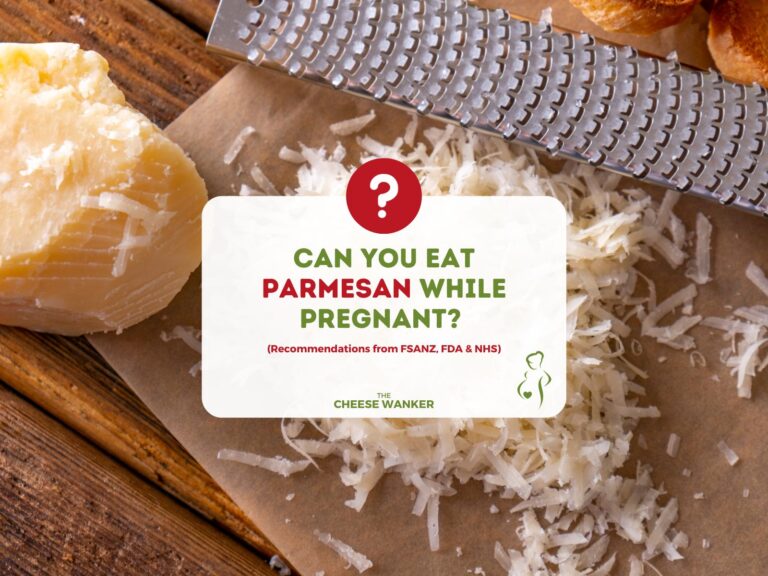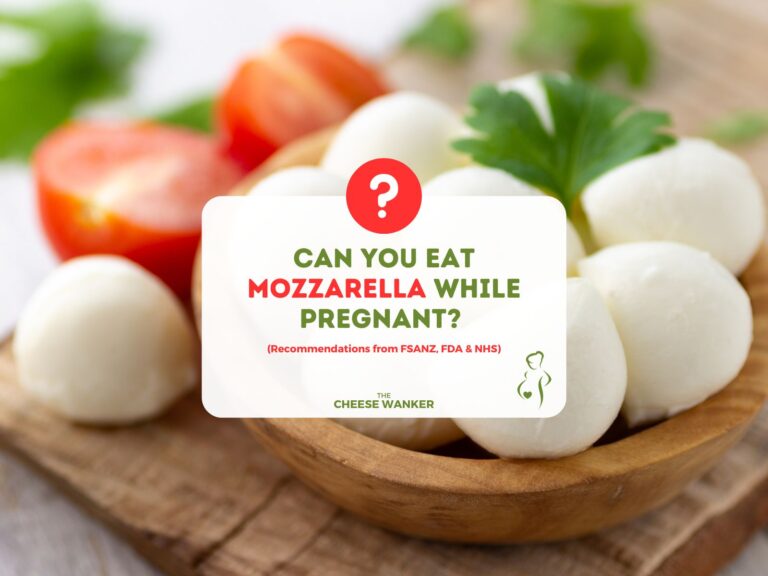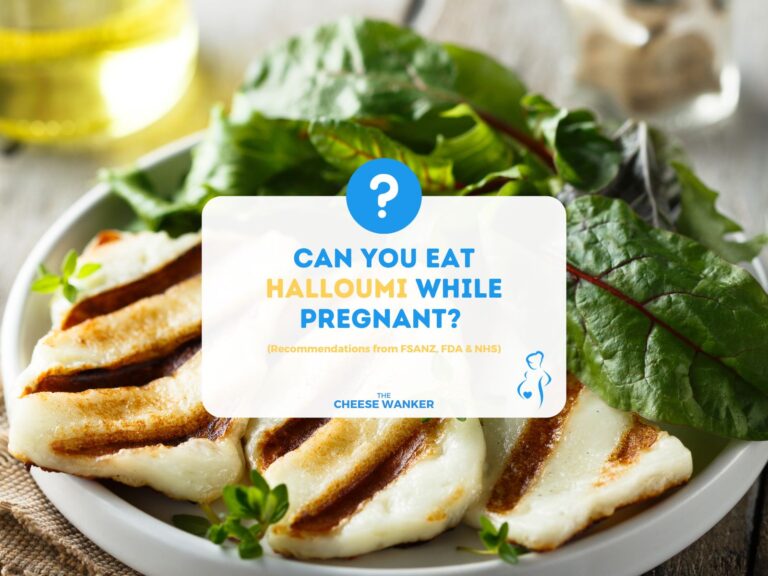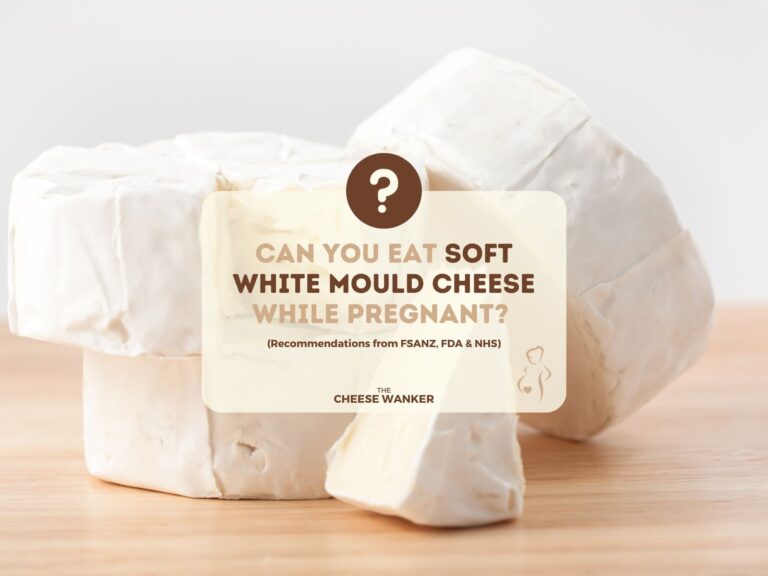Embarking on the beautiful journey of pregnancy often comes with a flood of questions about what’s safe and what’s not when it comes to food. Among the myriad of inquiries, the question of whether it’s safe to eat cheese during pregnancy takes centre stage. Fear not, for in this blog post, we’ll navigate the intricate landscape of cheese consumption during pregnancy, exploring the health benefits and potential risks.
The basics of pregnancy nutrition
During pregnancy, maintaining a well-balanced and nutritious diet is paramount for the health and development of both the mother and the growing foetus. The right nutrients provide essential building blocks for the baby’s organs, bones and overall growth, while also supporting the mother’s changing body and energy needs.
Here are the fundamental aspects of pregnancy nutrition:
1. Adequate protein intake
Protein is crucial for the development of the baby’s organs, muscles and tissues. Pregnant women should include sources of lean protein such as poultry, fish, tofu, legumes and dairy products in their diet. These proteins provide essential amino acids necessary for foetal development.
2. Essential vitamins and minerals
A variety of vitamins and minerals are vital during pregnancy. Folic acid, found in leafy greens and fortified cereals, helps prevent neural tube defects. Iron is necessary for the production of red blood cells and oxygen transport; it can be sourced from lean meats, poultry, fish, and fortified cereals.
Additionally, calcium is crucial for the baby’s bone development. And it is found in dairy products, fortified plant milks and leafy greens.
3. Omega-3 fatty acids
Omega-3 fatty acids, particularly DHA (docosahexaenoic acid), are essential for the baby’s brain and eye development. Rich sources include fatty fish like salmon, walnuts, flaxseeds and chia seeds.
4. Limiting certain foods
During pregnancy, it’s crucial to avoid certain foods like unpasteurised unaged cheeses, undercooked meats, raw fish and deli meats to reduce the risk of foodborne illnesses. Additionally, limiting caffeine and avoiding alcohol are important for the baby’s well-being.
Maintaining a balanced and varied diet, along with regular prenatal check-ups, ensures that both the mother and the baby receive the necessary nutrients for a healthy pregnancy and a strong start in life.
Consulting a healthcare provider or a registered dietitian for personalised guidance is invaluable to meet individual nutritional needs during this critical time.
Is cheese a healthy choice for pregnant women?
While certain foods are flagged as potential risks during pregnancy, cheese, in moderation, can be a delightful and healthful addition to an expectant mother’s diet.
Let’s explore why this dairy delight deserves a place on the plate of mothers-to-be.
Rich source of essential nutrients
Firstly, cheese is a nutritional powerhouse, packed with essential nutrients that support the overall well-being of both the mother and her growing baby.
Calcium, a vital mineral for bone development, is abundant in cheese. This is especially crucial during pregnancy, as the baby’s skeletal system is rapidly forming. Additionally, cheese provides an excellent source of protein, necessary for the development of the baby’s organs, muscles and tissues.
Folate for neural tube development
Folate, or folic acid, is a B-vitamin crucial during pregnancy for preventing neural tube defects in the developing foetus. Many types of cheese, such as Cheddar and Mozzarella, contain significant amounts of folate.
Including these cheeses in the diet helps ensure the proper development of the baby’s brain and spinal cord.
Energy boost and satiety
Pregnancy often comes with increased energy demands. Cheese, with its combination of protein and healthy fats, can be a satisfying and energy-boosting snack.
Including cheese in their diet can help pregnant women maintain steady energy levels throughout the day, combating fatigue and supporting overall well-being.
While cheese offers numerous health benefits during pregnancy, it’s important to consider the full picture. And this leads us to our next section.
Why are some foods not safe to eat when you’re pregnant?
While many foods contribute to a healthy and balanced diet, some are best avoided during pregnancy to mitigate potential risks. Understanding why certain foods are off-limits is crucial for ensuring a safe and healthy journey through this transformative period.
Raw or undercooked foods
Certain foods pose a higher risk of contamination with harmful bacteria, such as Listeria, Salmonella or E. coli. Raw or undercooked seafood, including sushi and raw or runny eggs, are among the culprits. These bacteria can lead to severe foodborne illnesses that may have adverse effects on both the mother and the developing foetus.
To minimise the risk of contamination, it’s essential to opt for well-cooked options.
Mercury levels in fish
While fish is an excellent source of omega-3 fatty acids crucial for foetal brain development, some types are high in mercury, which can be harmful to the developing nervous system.
Pregnant women are advised to limit their consumption of high-mercury fish such as shark, swordfish, king mackerel and tilefish. Instead, choose lower-mercury options like salmon, shrimp and catfish to enjoy the benefits of fish without the associated risks.
High moisture and unpasteurised cheeses
Soft cheeses like Brie and Queso Fresco can harbour harmful bacteria like Listeria. Ingesting Listeria during pregnancy may lead to serious complications, including miscarriage, stillbirth or preterm birth.
Moreover, raw milk versions of cheeses like Feta and Mozzarella are also at a higher risk of contamination. Opting for pasteurised versions of these cheeses ensures a safer choice for both mother and baby.
We’ll explore why those types are at higher risk of Listeria contamination a bit further down.
High salt content
During pregnancy, limiting high-salt foods is crucial for maintaining optimal health for both the mother and the developing baby. Excessive salt intake can contribute to elevated blood pressure, fluid retention and swelling, potentially leading to complications like pre-eclampsia and gestational hypertension.
The strain on the kidneys, coupled with potential implications for foetal development, underscores the importance of a balanced and moderate-salt diet.
Unfortunately, some types of processed cheese products contain excessive levels of salt. So, pregnant women should avoid eating those.
What is Listeria?
Listeria monocytogenes is a bacterium that can pose a serious threat to pregnant women and their developing babies. Knowing the symptoms and understanding how to seek timely treatment is crucial for ensuring a safe and healthy pregnancy.
Symptoms of Listeria infection
Listeria infection, also known as listeriosis, may present with mild symptoms in some individuals, but for pregnant women, the consequences can be severe. Common symptoms include:
Fever: Listeriosis often manifests with flu-like symptoms, including a persistent fever.
Muscle aches: Generalised muscle aches and pains may occur, contributing to an overall feeling of discomfort.
Gastrointestinal distress: Symptoms such as nausea, vomiting and diarrhoea may be present, resembling common gastrointestinal issues.
Headache: Persistent headaches are a common symptom of listeriosis, which may be accompanied by a stiff neck.
Pregnancy complications: In pregnant women, Listeria infection can lead to more serious complications, including miscarriage, stillbirth, preterm birth or severe illness in the newborn.
Seeking prompt medical attention
If you experience symptoms consistent with listeriosis, especially during pregnancy, seeking prompt medical attention is crucial. Healthcare providers can perform tests to confirm the presence of Listeria and initiate appropriate treatment.
Treatment for Listeria infection
Listeriosis is typically treated with antibiotics. It’s important for healthcare providers to prescribe antibiotics that are safe for both the mother and the developing baby. Early detection and intervention significantly improve the chances of a successful recovery and reduce the risk of complications.
Conditions that allow Listeria to thrive
Listeria monocytogenes thrives under specific conditions, and understanding these factors is essential for preventing contamination. Listeria can proliferate in:
Refrigeration temperatures
Listeria can survive and multiply at refrigeration temperatures, even as low as 4 °C (39.2 °F). This adaptability to cold environments is a concern for foods stored in refrigerators. Of course, its proliferation rate is even higher at room temperature.
High moisture
Furthermore, Listeria favours moisture-rich environments. High humidity, water or condensation on surfaces can create optimal conditions for the bacteria to persist and grow. Maintaining dry surfaces in food preparation areas is crucial.
This is the reason why high moisture cheeses like Brie and Queso Fresco are at a higher risk of contamination.
Low-acidity foods
Listeria can thrive in low-acidity environments. Foods with lower acidity levels, such as some blue cheeses and certain processed meats, provide an environment conducive to the growth of the bacterium.
Cross-contamination
Cross-contamination, where Listeria from one source contaminates another, poses a significant risk. This can happen when cutting boards, utensils or hands that have been in contact with contaminated food come into contact with ready-to-eat foods.
Extended storage durations
Listeria can multiply over time, particularly in foods with longer shelf lives. Prolonged storage periods increase the risk of bacterial proliferation, emphasising the importance of adhering to expiration dates and storage guidelines.
Inadequate cleaning practices
Finally, insufficient cleaning of food preparation areas, equipment and utensils can contribute to the persistence of Listeria. Rigorous cleaning and sanitation are critical for reducing the risk of contamination.
Cheeses that pregnant women should avoid
So, what are some of those high risk foods than may be contaminated with Listeria? They can include raw seafood and fish, cold meats, pre-packaged fruit and, yes, some cheeses.
Soft white mould cheese
Food safety authorities in Australia, the UK and the USA all agree on the following: pregnant women should avoid soft cheeses with a white mould rind such as Brie, Camembert and matured Chèvre.
Blue cheese
And the same rules apply for soft blue cheeses such as Danish Blue, Roquefort and Gorgonzola.
The reason for that is that they have a high moisture content and low acidity. As mentioned above, that combination provides the perfect environment for Listeria to proliferate.
Raw milk cheese
Overall, the authorities in Australia and the USA advise against the consumption of cheeses that are made with unpasteurised milk. Hence, raw milk Mozzarella and Feta are not recommended during pregnancy.
There is however one caveat to this. FSANZ (Australia & New Zealand) consider matured pressed raw milk cheeses such as Gruyère, Comté, Parmigiano Reggiano (Parmesan) and Pecorino Romano to have an equivalent safety profile to pasteurised matured cheeses. Hence, those aged varieties can safely be consumed even if made with raw milk.
Deli cheese
Pre-packaged or deli-counter sliced cheeses may be exposed to Listeria during handling and processing. Hence, it is best to avoid them if you’re pregnant.
Heavily processed cheese products
Some processed cheese products contain excessive levels of salt or less-than-ideal ingredients. Examples in this category include Velveeta and Cheez Whiz.
It’s advisable to check the labels and opt for products that are low in sodium.
Should you eat cheese rinds during pregnancy?
Whether it’s safe to eat the rind of cheese during pregnancy depends on the type of cheese and how it’s produced. The rind is the outer layer of a cheese, and its edibility varies.
Edible rinds
Some cheese rinds are intentionally edible and can add unique flavours and textures to the overall tasting experience. Examples include the rinds of certain aged cheeses like Comté and Gruyère. If the cheese label indicates that the rind is edible, and it has been properly stored and handled, it is generally safe to consume during pregnancy.
Waxed or cloth-covered rinds
Some cheeses have rinds that are coated with wax or cloth. Examples include Edam and Cheddar. In these cases, the rind is generally not meant to be eaten, and it’s advisable to remove it before consumption.
When in doubt, it’s always a good idea to check the specific guidelines provided by the cheese producer or the information on the product packaging.
Is the rind at higher risk of Listeria contamination?
So, most cheese rinds are designed to be edible. But is it safe to eat them if you’re pregnant?
Even though the risk of infection is low, Listeria contamination can also happen during the handling of cheese. As such, it would be advisable to avoid eating the rind of even hard cheeses during pregnancy.
What should you do if you’ve eaten unsafe cheese?
If you’ve consumed cheese that is potentially unsafe during pregnancy, there are several steps you can take:
Monitor for symptoms
Keep a close eye on your health and be vigilant for any symptoms of foodborne illness, particularly those associated with Listeria infection. Common symptoms include fever, muscle aches gastrointestinal issues, headache and, in severe cases, complications like miscarriage or preterm birth.
Seek medical attention
If you experience any symptoms or have concerns about the safety of the cheese you consumed, it’s essential to consult with your healthcare provider promptly. Early detection and treatment can be crucial in managing potential complications.
Diagnostic tests
If your healthcare provider suspects a foodborne infection, they may recommend diagnostic tests, such as blood tests or cultures, to identify the presence of bacteria like Listeria. Early diagnosis allows for timely intervention and management.
Stay hydrated
If you experience symptoms like vomiting or diarrhoea, it’s critical to stay hydrated. Drink plenty of fluids to prevent dehydration, especially if these symptoms persist.
Follow medical advice
Finally, follow any advice or recommendations provided by your healthcare provider. This may include taking prescribed medications, making dietary adjustments or undergoing further medical evaluations, depending on the circumstances.
What types of cheese can you safely eat when pregnant?
Now that we’ve got the bad stuff out of the way, let’s have a look at the long list of cheeses that are actually safe to eat while you’re pregnant. We’ve broken them down by cheese type for you.
Pasta filata cheese
Pasta filata cheeses such as Mozzarella, Burrata, Provolone, String Cheese and Caciocavallo are considered to be safe as long as they are made with pasteurised milk.
Given that Mozzarella is America’s favourite cheese, this is great news. Of course, the safety profile of this cheese extends to the traditional Mozzarella di Bufala (buffalo milk) and Fior di Latte (cow milk) versions.
Brined cheese
Furthermore, brined cheeses such as Feta, Halloumi and Marinated Goat Cheese are also considered to be safe while you’re pregnant. As was the case with pasta filata cheeses, the health authorities only consider pasteurised versions to be safe to eat during pregnancy.
The first two cheeses mentioned are very popular in salads and in a variety of dishes. We’ll get back to cooking with cheese a little bit later.
Soft and semi-soft rindless cheese
Another one of America’s favourites, Monterey Jack, falls under this category and is also safe if made with pasteurised milk. Also, you can add all variants of this cheese to the list of cheeses that can be eaten safely when pregnant. Some examples include Dry Jack and Pepper Jack.
On other type of cheese that falls under this umbrella is young goat’s milk cheeses without a rind.
Low moisture aged cheese
As we mentioned above, Listeria loves a moist environment. As cheese ages, it loses most of its water content. Therefore, aged cheeses like Parmigiano Reggiano, Gruyère, Manchego, Comté, Cheddar and Gouda are generally considered to be low-risk foods.
All of the cheeses mentioned except for Cheddar and Gouda are exclusively made with raw milk. However, as we mentioned earlier, the health authorities in most countries consider them to be as safe as pasteurised versions.
Can you make those unsafe cheeses safe by cooking?
This is where it gets really interesting. Thoroughly cooking any type of cheese until steaming hot will actually destroy any harmful pathogens that may be present in it. Indeed, most harmful bacteria like Listeria do not survive temperatures above 75°C/165°F.
What does all this mean? Well, if you are desperately missing your favourite soft cheese you can actually cook them to render them safer. Cheeses in this category include even unpasteurised ones such as Brie de Meaux, Camembert de Normandie and Mont d’Or.
Best pregnancy-friendly cheese recipes
Here are three pregnancy-friendly recipes using cheeses that would normally fall in the unsafe category during pregnancy. As mentioned above, you have to ensure that you cook those cheeses thoroughly to render them safe.
Grilled Halloumi Salad with Mixed Greens
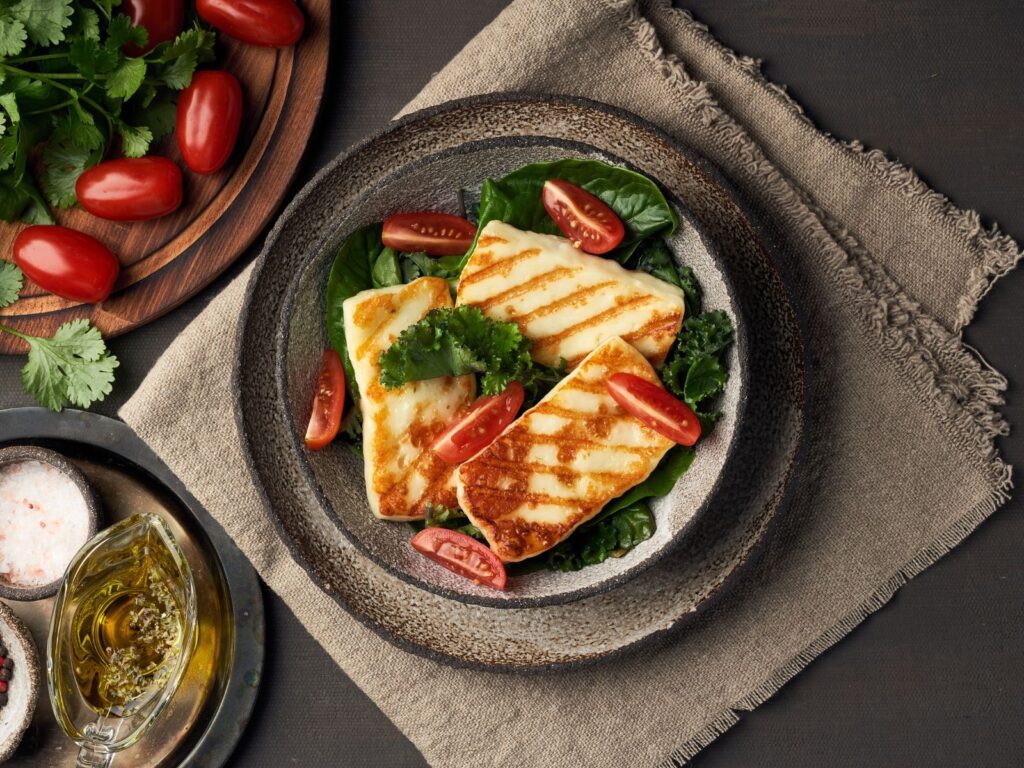
Grilled Halloumi takes centre stage in this refreshing salad. For this recipe, you can use either raw or pasteurised Halloumi.
Start by grilling your Halloumi slices until they’re golden and crispy. Toss a mix of spinach, rocket (arugula), watercress and cherry tomatoes in a bowl.
Drizzle with olive oil and lemon juice, then season with salt and pepper. Arrange the grilled Halloumi on top and garnish with fresh basil leaves for a delightful pregnancy-friendly salad.
Honey-Walnut Baked Camembert
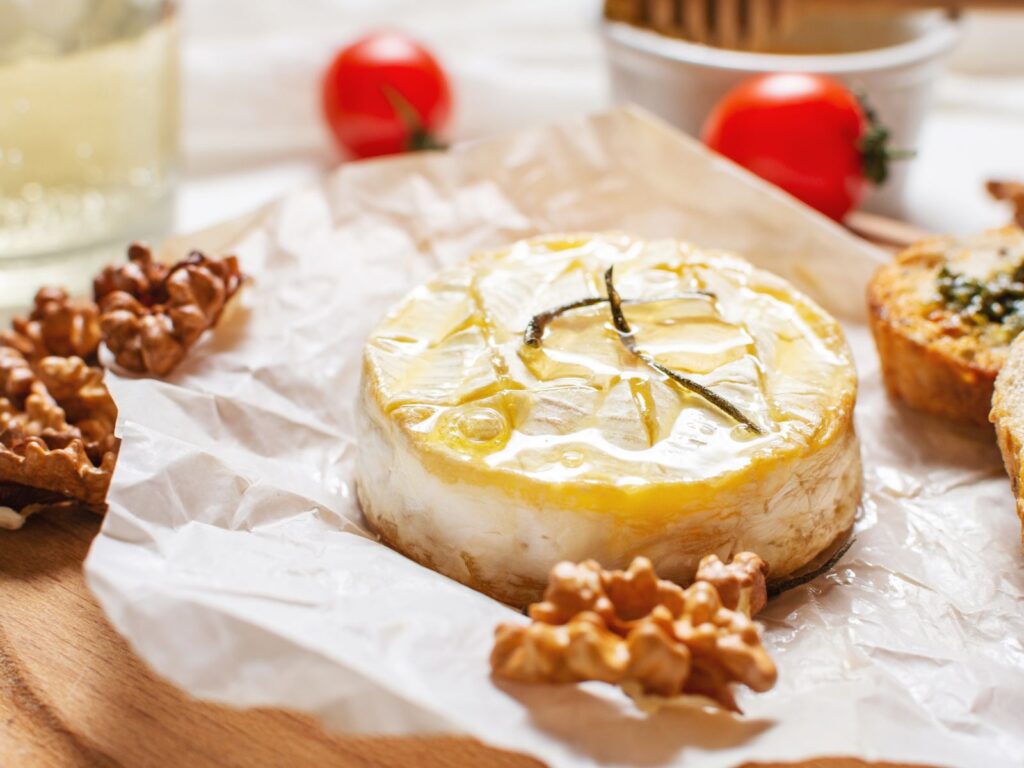
Experience the comforting flavours of a Honey-Walnut Baked Camembert. This simple yet elegant dish features a whole Camembert drizzled with honey, sprinkled with chopped walnuts and baked until irresistibly gooey.
Served with sliced apples and crackers, it’s a delightful pregnancy-friendly indulgence perfect for sharing or savouring solo.
Pear and Roquefort Tart
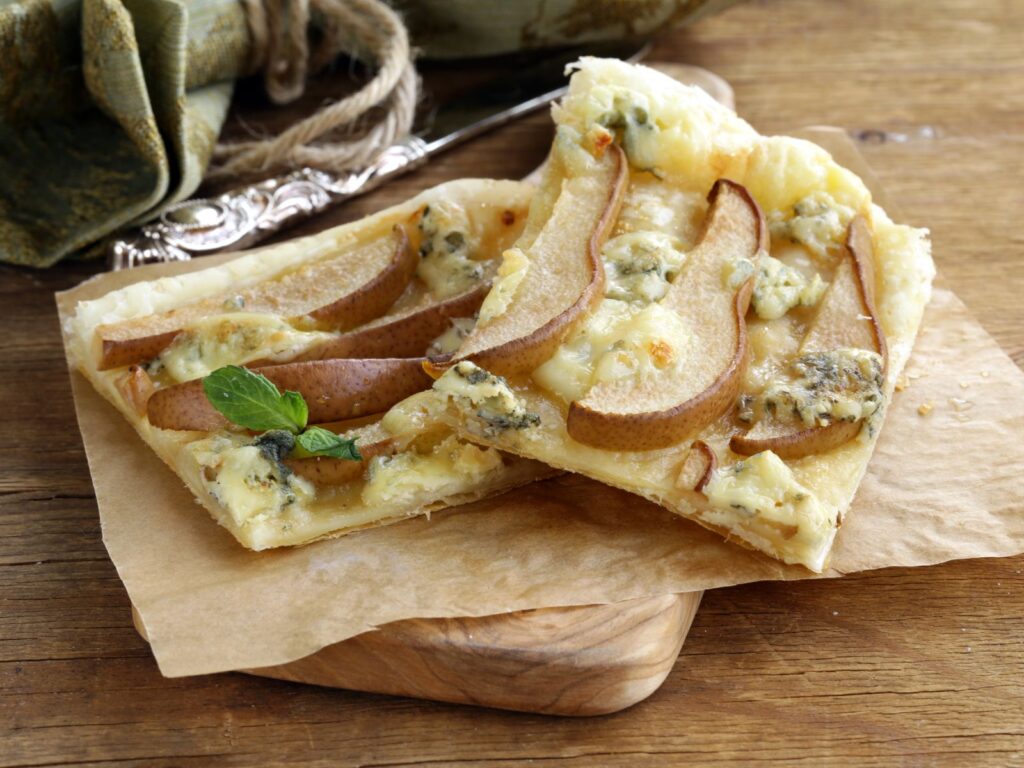
Indulge in the exquisite combination of sweet and savoury with this Roquefort and Pear Tart. This elegant dish features a buttery puff pastry crust as the canvas for a harmonious pairing of ripe, thinly sliced pears and crumbled Roquefort cheese.
The sweetness of the pears melds beautifully with the bold, savoury notes of Roquefort, creating a flavour symphony that dances across your taste buds. Baked to a golden perfection, this tart is a show-stopper, perfect for a sophisticated appetiser or a delightful addition to any cheese-centric gathering.
Conclusion
In conclusion, the question of whether you can eat cheese during pregnancy is a nuanced one. While certain varieties present potential risks due to bacterial contamination, a wealth of delicious and safe options remain available.
Navigating this culinary terrain involves informed choices and embracing the delights of cheese that enhance both nutritional intake and gastronomic satisfaction. With moderation, mindfulness and adherence to safe practices, you can savour the richness of cheese during pregnancy, adding a delectable dimension to your journey to motherhood.
Did we leave out one of your favourite cheeses in this post? Drop us a comment below and we can assess its safety during pregnancy.

References
Safety in Pregnancy
All the advice relating to what cheeses you can eat during pregnancy in this article is based on the recommendations by health authorities in Australia, the UK and the USA. If you are unsure about what you can or cannot eat, please consult your doctor.
Australia – FSANZ, United Kingdom – NHS and United Sates of America – FDA
Nutritional content
The nutritional content of cheese in our table comes from the USDA Food Data Central Repository and cheese manufacturers. We realise that there can be variations between different brands and producers. Hence, the numbers we have used are averages.
Fat
Our fat RDI data comes from Cleveland Clinic’s Healthy Fat Intake resource.
Type of fat in cheese as per Harvard T.H. Chan’s The Nutrition Source.
Protein
Our protein RDI data comes from Harvard Medical School’s Harvard Health Publishing.
